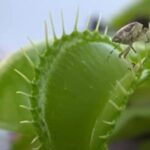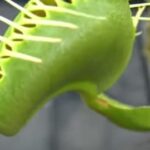As an Amazon Associate, this site earns commissions from qualifying purchases. For more details, click here.
Flowers like the Night Blooming Jasmine and Common Evening Primrose close at night and bloom in the morning. Since Venus flytraps are a flowering plant, you are probably wondering if it behaves in a similar manner. In fact, Venus flytraps are quite different from typical flowering plants.
Venus flytraps will open if the hair sensors on its traps are triggered, regardless if it is day or night. Without any stimuli, the traps will remain closed.
Why Venus Flytraps Open and Close Day or Night
Venus flytraps developed these traps to ensure it gets enough nutrients. Growing in soil that is inhospitable to other plants and flowers, its traps must be ready day or night to catch prey.
The traps of a Venus flytrap can close for a limited number of times before it dies and is replaced by another one. The plant has to make sure each one counts, so the trap or mouth only closes when specific conditions are met.
A trap consists of two leaves, and each has hair triggers on the lobes. If an object lands on the trap and sets off the trigger, a signal is relayed to the plant.
The plant waits for 20 to 30 seconds. If the trigger is not activated again, the trap will remain open. If the hair sensors are set off again, the trap shuts.
Prey can show up day or night, so a Venus flytrap needs to be ready at all times. Though Venus flytraps do not have consciousness, they are well adapted to their environment and sense things around their traps.
In short, a trap will not automatically shut when its triggers are activated. This is necessary because leaves, rocks and other objects could drop on the leaf.
This is important so the traps can save their energy for something edible. So even if Venus flytraps do not have eyes, their sensors work just fine.
If Venus flytraps are always closed at night, the plant might miss out on nearby bugs. It could wait all day and nothing comes into its traps, only for the bugs to come at night.
bugs are not necessary for Venus flytraps to survive. But the nitrogen in insects helps stimulate growth. Can Venus flytraps live without bugs? Yes, but their development will slow and the traps will not reach maximum growth potential. If there is limited prey available, you can feed the plant with the proper nutrients like Killer Plant Venus Flytrap Food.
Do Venus Flytraps Sleep at Night?
Venus flytraps go into dormancy as winter approaches, which is similar to hibernation. The plant shrinks and loses leaves, and it remains in this dormant stage until early spring.
There are many types of Venus flytraps but they all go into dormancy. This occurs slowly, beginning in late fall (not necessarily at night) and is completed by winter.
Dormancy may be likened to a long sleep, but it can also be considered a rebirth. As fall comes to a close, a Venus flytrap undergoes transformation.
Its traps start to fall and die off, followed by the other leaves. The plant looks sickly and shrinks. If you are a first time grower you can be forgiven for thinking the plant has died.
This mistake often causes people to try and save the plant, like watering or feeding it. This will harm the Venus flytrap because dormancy is part of its life cycle.
Whether you call it dormancy, a long slumber or rebirth, it is normal. When spring time comes, the plant will slowly reemerge or awaken. Leaves will start to appear and so will traps. Then you can start feeding the plant again. You can lt it catch insects or other types of food.
Venus flytraps have to be in dormancy for at least 10 weeks. The ideal period is 3 to 5 months. If dormancy ends in less than 10 weeks, the traps will not reach its full size potential.
A long dormancy is good, but long freezing winters are not. These plants can cope with frost and a typical freeze. But prolonged, harsh winters is not good for it.
if you have long harsh winters, it is best to move the plant indoors. Do not feed or water it. Just wait for the worst of the cold to end.
How Long Does a Venus Flytrap Stay Closed?
A Venus flytrap can take 3 to 12 days to digest its prey. Once the nutrients are absorbed the trap will reopen, leaving an exoskeleton or inedible parts behind.
If he trap captures something it cannot eat, the trap will reopen. It might take a few hours or a day, but the plant will detect the object is inedible and release it.
The traps of a Venus flytrap will remain closed for as long as it needs to extract the nutrients. It usually takes 3 to 5 days, but in some cases extend up to 12 days.
A Venus flytrap produces nectar to draw unsuspecting prey. When a bug steps onto its lobes and the sensors are triggered twice, the trap shuts.
The trap closes for two reasons, to keep the prey from escaping and to ensure bacteria does not set in too quickly.
The trap tightens the more a bug tries to flee. Eventually the trap becomes airtight, signaling to the plant to produce digestive juices and antiseptic fluids to keep it from decaying.
As explained earlier, the trap only shuts when two electrical signals are transmitted to the plant. If the triggers are not stimulated twice in 20-30 seconds, the trap will not close.
This is not a problem with bugs since they are likely to land on the hair triggers twice. But it is an issue if you are trying to feed a Venus flytrap freeze dried food like Value Grubs Mealworms. There is a workaround for this however.
If you want to feed dead bugs or worms to a Venus flytrap, cut them into small pieces so they fit in the trap. Place the bits on the leaves. Use a toothpick or some other object to gently prod the trap into closing, and when it does, the plant will digest the food.
Why are All My Venus Flytraps Closed?
Venus flytraps do not need to have all traps fed. Even those that grow in the wild or outdoors usually have just one trap closed.
If all the traps are closed, it is a sign of stress, lack of nutrition or other health conditions. Make sure your Venus flytrap gets enough sunlight, water and insects. Or you can give them food so it does not have to depend on insects entirely.
Venus flytraps consume bugs out of need for nutrients. Native to South and North Carolina, these plants are found in nutrition poor soil. In order to survive, the plant uses its traps to catch insects and extract nitrogen that it needs to grow.
A Venus flytrap only eats what it requires, and usually one bug per week is enough. So it is very unlikely for the plant to have all of its traps closed.
In some cases a Venus flytrap might catch a couple of bugs. Unless you have a swarm of ants around the plant however, there is no way all 5 or 7 traps should be closed simultaneously.
If that is the case, look for signs of rot in the traps. The plant might also be lacking water or sunlight. It could also be due to too much sun. 6 hours per day is the minimum required and 8-12 hours is ideal.
Stressed Venus flytraps might also close all its traps. This could be due to changes in its environment and the plant is struggling to adapt. Give it some time to adjust to its new settings.
If the plant is entering dormancy stage, it could be a prelude to its discarding the traps and leaves. In that case it is normal, but you should still keep an eye on the rest of the plant.
Conclusion
The more you learn about Venus flytraps the more fascinating they are. And knowing as much about the plant is essential to keeping the traps healthy and lively.

My fascination with carnivorous plants began many, many years ago with Venus Fly Traps. Now I am more than happy to impart what I know with other enthusiasts and those who are curious about meat eating plants.



